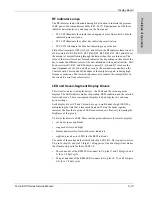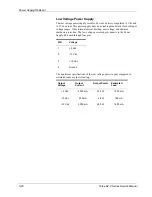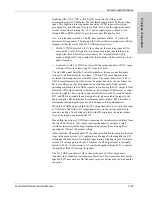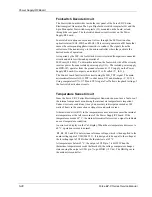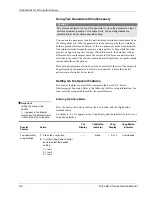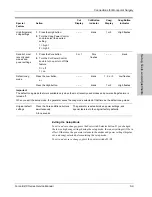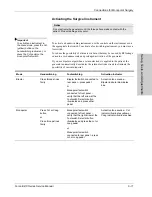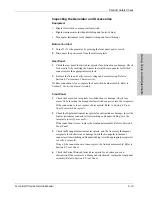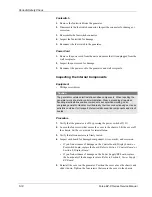
Power Supply/RF Board
Principles of Operation
Force EZ-C Series Service Manual
5-27
Enabling either UP_TONE\ or RF_TONE\ low pulls the voltage at the
noninverting input of U5B below the Vref threshold present at U5B’s inverting
input. This condition turns the output transistor of U5B (open collector) on,
grounding R31 and allowing U6A to oscillate. Vref, used throughout the audio
circuit, results from dividing the +12 V power supply down to about 2 volts
through R50 and R54 while C33 provides low pass filtering for Vref.
U6A is a relaxation oscillator: The RC time constants of R29, C11, and C42
determine its frequencies. This design allows the oscillator to produce two distinct
frequencies that the state of the LO_TONE signal can select.
•
With LO_TONE asserted (+5 V), the voltage at the inverting input of U5A
exceeds the 2 volt Vref signal at its noninverting input, thus turning on its
output transistor. This effectively connects C11 in parallel with C42 to
produce a higher RC time constant for the oscillator, which results in a lower
audio frequency.
•
Conversely, with LO_TONE not asserted, the output transistor of U5A (open
collector) floats, thus removing C11 from the circuit.
The ALARM signal from the Control board selects the user-controlled audio
volume or the fixed alarm level volume. U5C and U5D are configured in an
exclusive OR arrangement in which the state of the output transistor of U5C or
U5D is complementary. In other words, the output transistor of one of these two
devices is always on, but both cannot be on simultaneously. Under normal
operating conditions, the ALARM signal is low, allowing the U5C output to float
while the U5D output transistor is turned on. The output of U5D creates a voltage
divider through R1 (the volume control potentiometer on the Footswitch board),
R27, and R28 to attenuate the audio signal to levels acceptable for input to the
audio amplifier. R27 determines the minimum audio volume. R55 provides an
alternate audio signal path in the event of an open volume potentiometer.
When the ALARM signal is high, the U5C output transistor is on while the output
of U5D floats. When the U5C output transistor is on, the system pulls R26 to
ground, creating a fixed voltage divider with R28 to produce the alarm volume
level at the input to audio amplifier U8.
Meanwhile, the output of U5D floats, removing the variable resistor divider from
the circuit. In this case, the volume control potentiometer becomes a small
resistance in series with the high impedance input from the audio amplifier,
negating the effect of the volume setting.
Audio amplifier U8 and speaker SP1 (on the Footswitch board) comprise the final
stage in the audio system. AC coupling the audio signal to the amplifier by C43
eliminates the need for well controlled input biasing. Floating its gain select pins
sets the U8 voltage gain to about 20. Because the U8 output signal is internally
biased to Vcc/2, it is necessary to AC couple the speaker through C51 to prevent
the amplifier from DC biasing the speaker.
The LO_TONE signal drives Q3 to change the gain of U8 to compensate
(equalize) the volume for low frequency operation. This is necessary because the
speaker (SP1) does not have flat frequency response between the cut tone and the
coag tone.
Содержание Force EZ - C Series
Страница 1: ...Service Manual Valleylab Force EZ C Series Electrosurgical Generator with Instant Response Technology...
Страница 6: ...vi Force EZ C Series Service Manual...
Страница 20: ...1 6 Force EZ C Service Manual...
Страница 64: ...4 30 Force EZ C Series Service Manual...
Страница 156: ...7 26 Force EZ C Series Service Manual...
Страница 158: ...Interconnect Diagram 8 2 Force EZ C Series Service Manual Interconnect Diagram Figure 8 1 Electric cable connections...
Страница 208: ...10 18 Force EZ C Series Service Manual...

